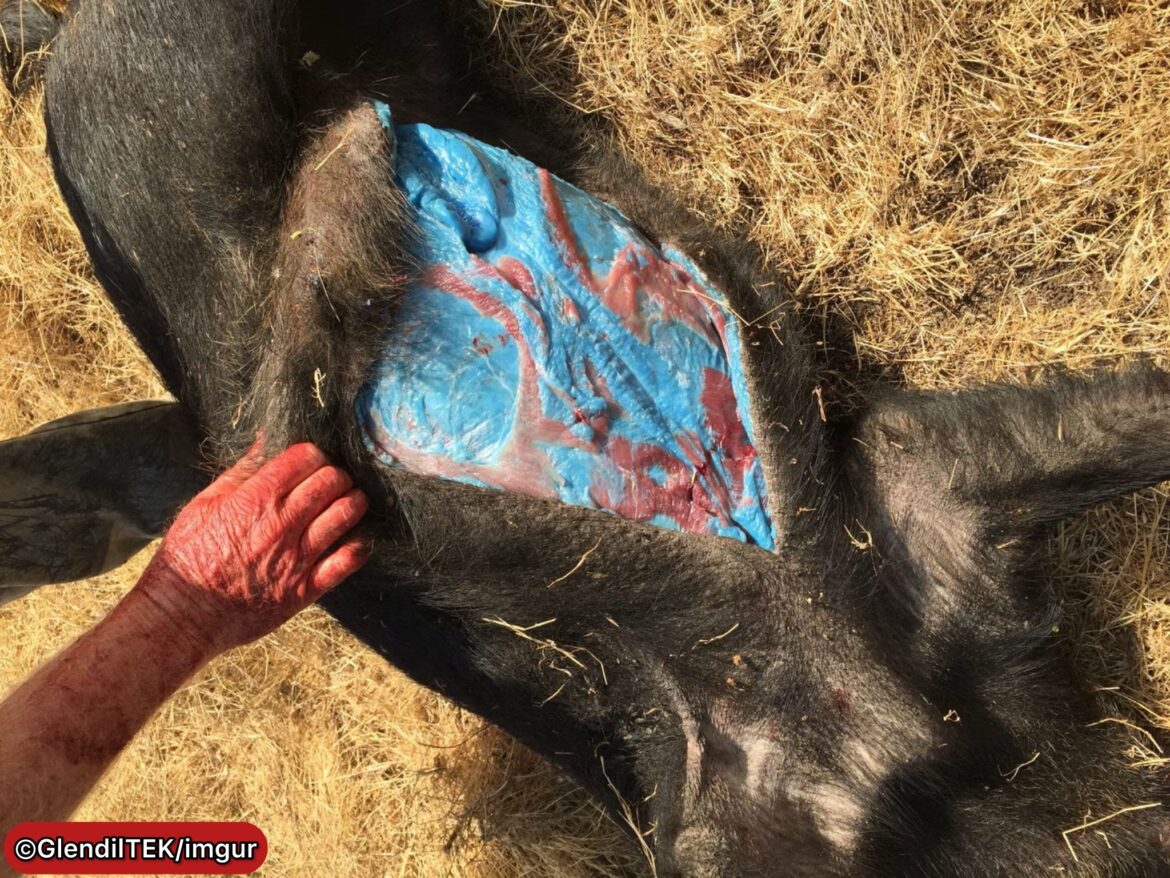Authorities issue alert after trappers discover ‘blueberry blue’ meat linked to rodenticide poisoning in Monterey County
Californian authorities have issued urgent warnings after trappers once again reported finding wild pigs with “bright blue” flesh, a bizarre phenomenon that signals the animals have been poisoned by consuming pesticide bait.
The California Department of Fish and Wildlife said it had received reports of the unusual occurrence in March, confirming that the neon blue discoloration is a sign the animals have ingested rodenticide containing Diphacinone, a poison that prevents blood from clotting.
“It’s wild,” Dan Burton, owner of Urban Trapping Wildlife Control, who first reported the oddly coloured flesh, told The Los Angeles Times. “I’m not talking about a little blue… I’m talking about neon blue, blueberry blue.”
Burton made the startling discovery whilst processing wild pigs he had trapped on an 800-acre ranch near Salinas in Monterey County. When he cut open the animals, he found their fat and muscle tissue had turned a vivid “7-Eleven slushie blue” beneath the skin.
A statement issued by the CDFW last week revealed that wild pigs in the Monterey County area had been exposed to pesticide bait containing the anticoagulant rodenticide Diphacinone, which causes internal bleeding in rodents and ultimately kills them.
The department explained that blue tissue and flesh can be a sign of rodenticide ingestion, which can occur by eating bait directly or consuming other animals that have ingested the substance. The bait often contains blue dye to identify it as poison.
“Hunters should be aware that the meat of game animals, such as wild pig, deer, bear and geese, might be contaminated if that game animal has been exposed to rodenticides,” said CDFW Pesticide Investigations Coordinator Dr Ryan Bourbour.
He added: “Rodenticide exposure can be a concern for non-target wildlife in areas where applications occur in close proximity to wildlife habitat.”
Burton’s investigation revealed a disturbing pattern. He observed pigs deliberately breaking into ground squirrel bait stations to access the poisoned oats inside. “They were just beating the heck out of these bait stations, knocking the poison out,” he said. “And then they were fighting over this ground squirrel poison.”
The contamination appears widespread across southern Monterey County and along the Salinas River, with multiple pigs showing signs of exposure. On one property, we checked 12 or 13 pigs, and they were all blue on the inside,” Burton reported.
Laboratory tests conducted by the CDFW’s Wildlife Health Lab and the California Animal Health and Food Safety Laboratory at UC Davis confirmed the presence of Diphacinone in the pigs’ liver and stomach contents.
The emergence of blue pigs in California is not the first occurrence of the phenomenon. In September 2015, Imgur user GlendilTEK posted a series of images online titled “The Weird Pig” showing a wild pig with fluorescent blue fat shot at a Morgan Hill ranch. The images went viral, receiving more than a million views.
That pig was ultimately found to have also been poisoned with rodenticide, establishing a pattern that has now repeated a decade later.
The problem extends beyond wild pigs. A 2018 study of anticoagulant rodenticide exposure in game animals across California found concerning levels of contamination throughout the food chain. The research discovered anticoagulant rodenticide residue in just over 8 percent of wild pig tissue samples collected, largely from animals frequenting agricultural or residential areas where rodenticides are commonly utilised.
More alarmingly, the same study found that 83 percent of bear tissue samples contained the poison. Other affected species included mountain lions, with more than half of 64 tested showing Diphacinone contamination, as well as California condors, bobcats, San Joaquin kit foxes, red-tailed hawks and northern spotted owls.
It’s really widespread poisoning,” said Jonathan Evans, Environmental Health Legal Director at the Center for Biological Diversity. The ability of the anticoagulants to bioaccumulate through the food web is dramatic.
Despite a 2024 law that banned Diphacinone for most uses in California, agricultural operations retain exemptions due to their pest control needs. The poison remains legal when used by certified vector control technicians, government agencies, or at agricultural sites.
This loophole has created what experts describe as an ecological paradox. Whilst the state banned lead ammunition in 2019 to protect California condors from poisoning, the continued agricultural use of rodenticides poses a similar threat to wildlife.
You know, the state banned lead ammunition all those years ago to protect the condor,” Burton observed. “And then, you know, we have these pigs eating this poison.”
Officials warn that the blue colouration may not always be present even in contaminated flesh, making it difficult for hunters to identify affected animals. The toxin persists in tissue and is not destroyed by cooking, posing health risks to humans who consume the meat.
Bryan Flores, Chief of Monterey County Parks, emphasised the danger: “That’s a clear signal to anyone who hunts and plans to eat an animal. If you cut it open and the tissue is blue, you don’t eat blue meat.”
The CDFW has asked anyone who encounters an animal with blue fat or tissue to contact the agency at whlab@wildlife.ca.gov or (916) 358-2790. The department is urging landowners to use appropriate bait stations and take steps to ensure wildlife other than rodents cannot access areas where pesticides are applied.
Burton expressed particular concern for young hunters who might not recognise the warning signs. The pigs, weighing between 100 and 200 pounds, appeared to act normally despite their tissue being visibly affected by the poison, as they had consumed bait meant for much smaller animals.
Follow for more updates on Britannia Daily



